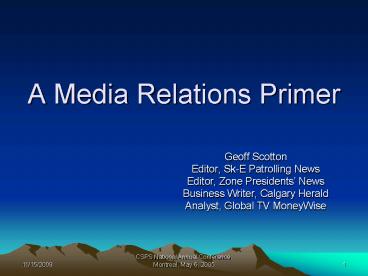A Media Relations Primer - PowerPoint PPT Presentation
1 / 27
Title:
A Media Relations Primer
Description:
Business Writer, Calgary Herald. Analyst, Global TV MoneyWise. 7/26/09 ... CSPS National Annual Conference, Montreal, May 6, 2005. 3. What, why and who ... – PowerPoint PPT presentation
Number of Views:28
Avg rating:3.0/5.0
Title: A Media Relations Primer
1
A Media Relations Primer
- Geoff Scotton
- Editor, Sk-E Patrolling News
- Editor, Zone Presidents News
- Business Writer, Calgary Herald
- Analyst, Global TV MoneyWise
2
Journalist humour
3
What, why and who
- Demystify the media
- Show how it can help you and the CSPS
- Im a Patroller since 2002 and a reporter and
editor since 1989 in - Radio
- TV
4
Topics of Discussion
- Why the media matters to you
- Finding/keeping media contacts
- Positioning you and your patrol
- The CSPS media paradox
- Fundamentals of press releases
- Make it easyand why
- Key messaging
5
Why the media matters
- Print, TV, Radio and Internet media is pervasive
and powerful - Studies show articles are seen as 10 times more
trustworthy and unbiased than ads - Media coverage is free
- The media can help you meet your goals
6
Why the media matters
- Positive coverage can and will
- Spread the safety message
- Raise the profile of the CSPS
- Give a needed boost to recruiting
- Support fund-raising efforts
- Heighten sense of team
- Improve sense of worth and contribution
- Buttress CSPS within snow industry
7
Finding media contacts
- Identifying local media is as close as your
paper, TV or radiotelephone or computer - Easy opportunities already exist via Community
calendars - Find the right person Sports? Local News?
Health? Recreation?
8
Finding media contacts
- Consider community, college, university print
TV cable and radio - Lazy? Media staff by outlet can be found in
Matthews Media Directory or Bowdens Media
Directory.. At the library. - Names, numbers and email addresses are just the
beginning
9
Cultivating the media
- Journalists are human too and like the human
touch - Relationship building is critical
- Bait the hook
- Consider your timing. Mornings Tuesday to
Thursday are best - Make it interesting!
- Be persistent but not pesky
10
Source positioning
- Most effective way to gain ongoing positive media
interest is to position the CSPS as an authority - Snow safety
- Fitness
- First Aid/Rescue
- Community builder
- Winter lovers
11
CSPS media paradox
- The most exciting thing we do is deal with nasty
accidents - The one thing we cant talk to the media about
is nasty accidents - Sowe must appeal to emotion
12
Press release fundamentals
- Make it newsworthy. (As possible)
- Pithy, exciting headline
- Summarize, hook and 5Ws in first paragraph
- Details in subsequent paragraphs
- Spelling and grammar must be correct. Dont rely
on spell cheque - Contact must be reachable
13
Press release fundamentals
- Ensure quotes add or support release information,
not repeat it - One page is best, two the limit
- Accuracy, with excitement, is key
- Good example at http//www.webwire.com/FormatGuid
elines.asp
14
Make it easy
- Big city journalists have access to 20,000 news
stories. A day. - Reporters are not waiting around for the phone to
ring - Most newspapers and news shows should be called
- The Daily Miracle
15
How to help?
- Have photos or graphics available
- Have a backgrounder prepared
- Be able to supply names and contact information
for third parties - Make sure contact is reachable
16
Interview tips
- Know your subject, but admit it when you dont
know the answer - Study and practice. Be prepared
- Notes are OK. For your use only
- Relax
- TV Blue shirt, dark tie, dark jacket, hair
combed, face shaved, modest makeup. Talk to the
interviewer
17
Key messaging
- The reporter controls the interview you control
the content and the outcome - Key messaging is a recognized media relations
technique - Focus is on repetition and emphasis on three to
four key phrases
18
Key messages
- A phrase of four to 15 words you want to see in
every story - Create three or four key message points
- Imagine the headline
- Brainstorm, recite, review, revise and repeat
19
Key messages
- For each key message you should be able to
provide two to four support points for its
premise - For each key message you should be able to
provide an example or sketch - In other words Be able to elaborate
informatively and accurately
20
Summing Up
- Working with the media is not difficult and can
be very rewarding if you do your homework - Remember
- Research
- Prepare
- Have a critical eye
- Be helpful
21
Next Steps
- Enormous resources are available at the library
and online. Take advantage of them - Get to know your local media
- Think about coverage opportunities
- Have fun. Your first accident scene was scary
too!
22
Some sources
- http//www.aboutpublicrelations.net/mediarel.htm
- http//www.webwire.com/FormatGuidelines.asp
- http//www.publicaffairs.ubc.ca/facultystaff/diy/
23
Making it easyto reach me
- geoffscotton_at_shaw.ca
- geoffscotton_at_skipatrol.ca
- nakiskarostergod_at_cspscalgary.ca
- info_at_cspscalgary.ca
- gscotton_at_theherald.canwest.com
- (h) 403-230-5728
- (w) 403-235-7478
- (toll-free) 1-800-838-8994, ext. 7478
- (c) 403-813-4324
24
Journalist humour
25
Journalist humour
26
Journalist humour
27
- - 30 -































